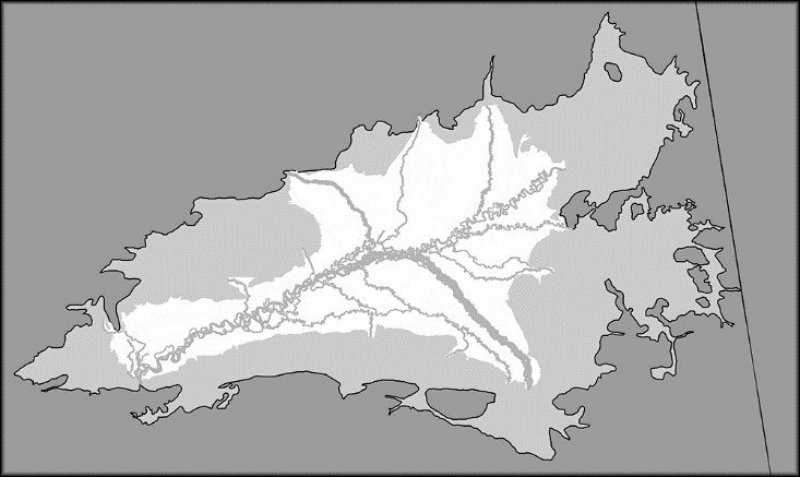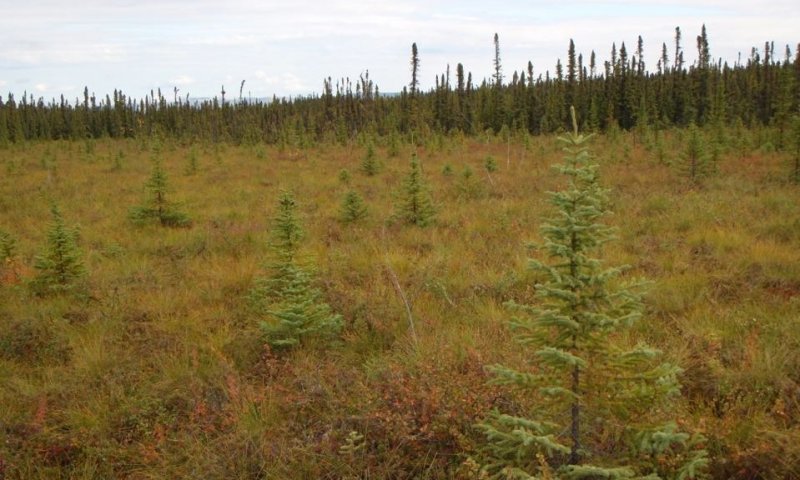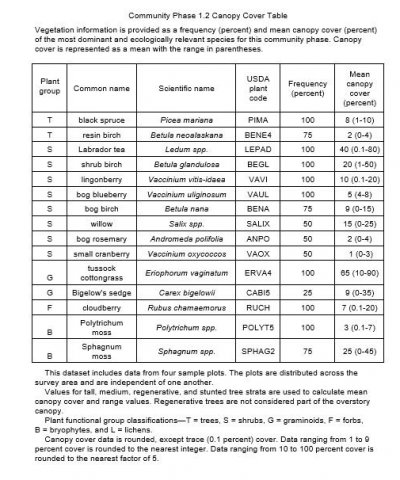

Natural Resources
Conservation Service
Ecological site XA232X02Y217
Boreal Woodland Loamy Frozen Plain Wet
Last updated: 5/18/2020
Accessed: 01/10/2025
General information
Provisional. A provisional ecological site description has undergone quality control and quality assurance review. It contains a working state and transition model and enough information to identify the ecological site.
MLRA notes
Major Land Resource Area (MLRA): 232X–Yukon Flats Lowlands
The Yukon Flats Lowlands MLRA is an expansive basin characterized by numerous levels of flood plains and terraces that are separated by minimal breaks in elevation. This MLRA is in Interior Alaska and is adjacent to the middle reaches of the Yukon River. Numerous tributaries of the Yukon River are within the Yukon Flats Lowlands MLRA. The largest are Beaver Creek, Birch Creek, Black River, Chandalar River, Christian River, Dall River, Hadweenzic River, Hodzana River, Porcupine River, and Sheenjek River. The MLRA has two distinct regions—lowlands and marginal uplands. The lowlands have minimal local relief and are approximately 9,000 square miles in size (Williams 1962). Landforms associated with the lowlands are flood plains and stream terraces. The marginal uplands consist of rolling and dissected plains that are a transitional area between the lowlands and adjacent mountain systems. The marginal uplands are approximately 4,700 square miles in size (Williams 1962).
This MLRA is bounded by the Yukon-Tanana Plateau to the south, Hodzana Highlands to the west, Porcupine Plateau to the east, and southern foothills of the Brooks Range to the north (Williams 1962). These surrounding hills and mountains partially isolate the Yukon Flats Lowlands MLRA from weather systems affecting other MLRAs of Interior Alaska. As a result, temperatures are generally warmer in summer and colder in winter than is characteristic in other areas at comparable latitude. There is a moisture and temperature gradient in which the lowlands region tends to be drier and colder and the surrounding marginal uplands region tends to be moister and warmer (PRISM Climate Group 2006).
The Yukon Flats Lowlands MLRA is mostly undeveloped lands that are sparsely populated and not accessible by a road system. A number of villages, including Beaver, Birch Creek, Chalkyitsik, Circle, Fort Yukon, Stevens Village, and Venetie, are adjacent to the Yukon River or one of its major tributaries. The largest village is Fort Yukon, which according to the 2010 U.S. Census has 583 residents that are dominantly Gwich’in Alaska Natives.
LRU notes
Alaska has no officially recognized LRU. However, there appear to be two distinct LRU in the Yukon Flats Lowlands MLRA. These LRU are thought to have differing climatic regimes, landforms, and soil types (STATSGO and Jorgensen and Meidinger 2015). The two LRU were previously discussed in the MLRA notes section above and are termed the lowlands LRU, and the marginal uplands LRU.
This ecological site is associated with the marginal uplands LRU.
Classification relationships
Yukon Flats Lowlands MLRA.
Ecological site concept
This ecological site occurs where water accumulates on the slopes (i.e. lower third of slopes and swales) of the marginal uplands region of the Yukon Flats Lowlands MLRA. The marginal uplands are characterized by broad and extensive plains. Associated soils have very deep loess deposition, are prone to ponding, and are considered poorly drained. The reference state supports two plant communities related to a fire regime.
The reference plant community phase is characterized as needleleaf woodland (10 to 25 percent cover; Viereck et al. 1992) primarily composed of black spruce (Picea mariana). Commonly observed understory species include bog Labrador tea (Ledum groenlandicum), bog blueberry (Vaccinium uliginosum), lingonberry (Vaccinium vitis-idaea), bog birch (Betula nana), shrub birch (Betula glandulosa), Bigelow's sedge (Carex bigelowii), tussock cottongrass (Eriophorum vaginatum), splendid feathermoss (Hylocomium splendens), and Sphagnum moss (Sphagnum spp.).
Associated sites
| XA232X02Y210 |
Boreal Forest Loamy Frozen Plains Warm This ecological site occurs in the marginal uplands region of the Yukon Flats Lowlands MLRA. The marginal uplands are characterized by broad and extensive plains. This ecological site occurs on warm slopes of these plains. Associated soils have very deep loess deposition and are well drained. The reference plant community phase is characterized as an open needleleaf forest (25 to 60 percent cover; Viereck et al. 1992) primarily composed of mature white spruce (Picea glauca). |
|---|---|
| XA232X02Y227 |
Boreal Forest Loamy Frozen Plains Cold This ecological site occurs in the marginal uplands region of the Yukon Flats Lowlands MLRA. The marginal uplands are characterized by broad and extensive plains. This ecological site occurs on colder slopes of these plains. Associated soils have very deep loess deposition and range from poorly to somewhat poorly drained. The reference plant community is characterized as an open needleleaf forest (25 to 60 percent cover; Viereck et al. 1992) primarily composed of black spruce. |
| XA232X02Y211 |
Boreal Loamy Escarpments This ecological site is associated with steep and erosive escarpments in the marginal uplands region of the Yukon Flats Lowlands MLRA. During field work, these escarpments were not sampled and this ecological site is currently a provisional concept. |
| XA232X02Y203 |
Boreal Scrub Loamy Frozen Drainages This ecological site occurs in the marginal uplands region of the Yukon Flats Lowlands MLRA. The marginal uplands are characterized by broad and extensive plains. This ecological site occurs in drainageways on these plains. Associated soils flood occasionally (5 to 50 times in 100 years) for long durations of time (between 7 and 30 days). Soils range from poorly to very poorly drained. The reference plant community is characterized as closed tall scrub (Viereck et al. 1992). Black spruce commonly occurs but cover is generally low. |
| XA232X01Y201 |
Boreal Woodland Peat Frozen Terraces This ecological site occurs in organic rich bogs in the lowlands and marginal uplands regions of the Yukon Flats Lowlands MLRA. The cumulative thickness of organic material often exceeds 50 inches in the soil profile. Reference state soils are poorly drained and organic material is considered ultra to extremely acidic. The soils associated with the reference plant community generally have permafrost at moderate depth (20 to 40 inches). This ecological site has an alternative state related to thermokarst. |
Similar sites
| XA232X01Y201 |
Boreal Woodland Peat Frozen Terraces XA232X01Y201 is associated with bogs in both the lowlands and marginal uplands LRU in the Yukon Flats Lowlands MLRA. While XA232X01Y201 and XA232X02Y217 both support black spruce woodlands, XA232X01Y201 has more Sphagnum ground cover and appears more prone to thermokarst after fire events. |
|---|---|
| XA232X02Y227 |
Boreal Forest Loamy Frozen Plains Cold XA232X02Y227 supports black spruce open forests in drier landform positions adjacent to this ecological site. |
| XA232X01Y262 |
Boreal Woodland Gravelly Terraces This ecological site has similar reference state plant community communities but occurs on gravelly stream terraces in the Lowlands LRU in the Yukon Flats Lowlands MLRA. |
| XA232X01Y209 |
Boreal Tussock Loamy Frozen Terraces This ecological site has similar reference state plant communities but occurs on stream terraces in the Lowlands LRU in the Yukon Flats Lowlands MLRA. |
| XA232X01Y218 |
Boreal Woodland Loamy Frozen Terraces This ecological site has similar reference state plant communities but occurs on stream terraces in the Lowlands LRU in the Yukon Flats Lowlands MLRA. |
Table 1. Dominant plant species
| Tree |
(1) Picea mariana |
|---|---|
| Shrub |
(1) Carex bigelowii |
| Herbaceous |
(1) Hylocomium splendens |
Legacy ID
F232XY217AK
Click on box and path labels to scroll to the respective text.






